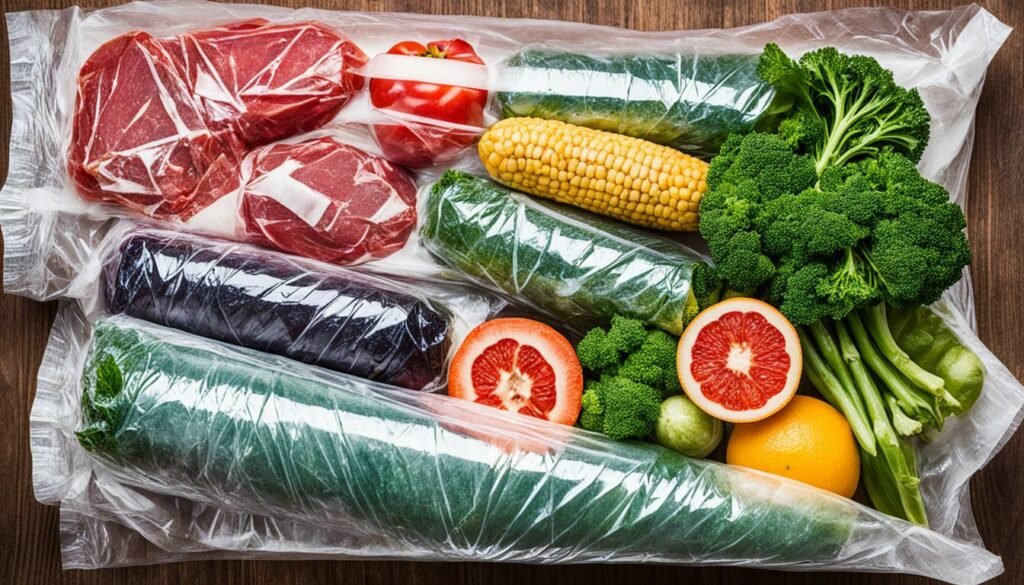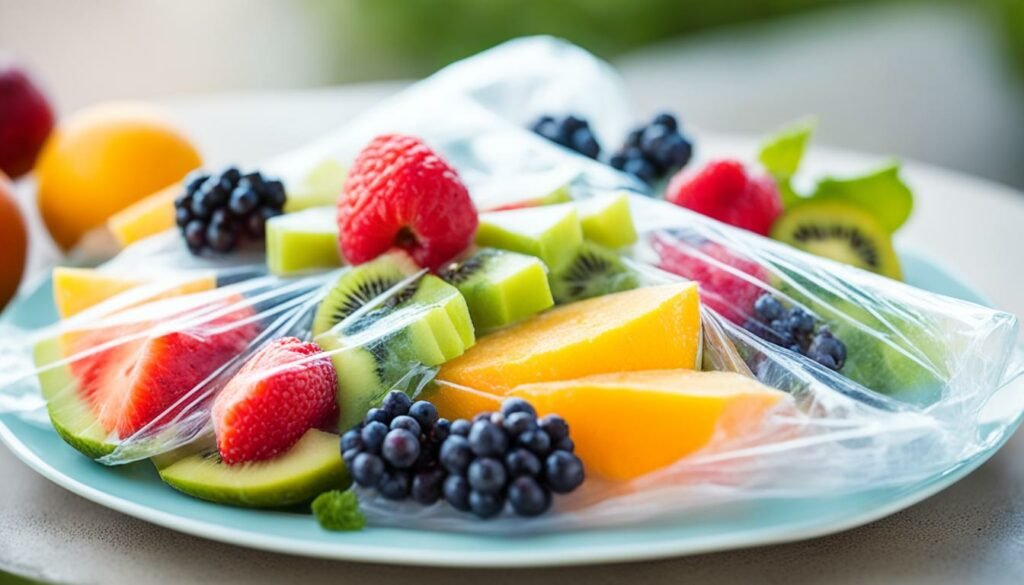Ever wondered if there’s an easy way to keep your food fresh without buying costly equipment? After testing out different methods, I found cling film to be a game-changer. It ensures my food stays fresh without the need for a vacuum sealer.

Cling film isn’t just for covering leftovers. It’s a powerful food storage tool that can compare to vacuum sealing. Whether I’m wrapping up fish or storing veggies, cling film does the job well. And, it’s a cheaper option that doesn’t skimp on quality.
One person shared that a single Kirkland cling wrap roll lasted them five years. This, along with its ability to keep food fresh, makes cling film stand out. Plus, it shields food from freezer burn, keeping its taste intact. This quality has left many, including me, impressed. Here’s an example of cling wrap keeping food fresh.
Let’s take a closer look at how cling film measures up to vacuum sealing. I’ll explain why it could change how you store food efficiently in your kitchen.
Introduction to Food Preservation Methods
Keeping food fresh is vital in our lives. I have seen how using good storage methods keeps food from going bad. This also helps lower waste. We will talk about methods that lengthen shelf life and stop food from being exposed to air.
The Importance of Proper Food Storage
Storing food the right way is crucial. It keeps food fresh and safe. I discovered that correct storage can prevent bacterial growth and keep nutrients. This helps reduce waste and save money on groceries too.
Traditional Vacuum Sealing vs. Modern Alternatives
Vacuum sealing has long been used to keep food fresh. but I found that cling film works just as well. Below are comparisons of these two methods:
| Feature | Vacuum Sealing | Cling Film |
|---|---|---|
| Equipment needed | Specialized machine and bags | Simple roll of film |
| Cost | Higher initial investment | More affordable |
| Ease of use | Requires some practice | Quick and straightforward |
| Shelf life extension | Excellent | Good |
| Air exposure prevention | Very effective | Effective |
Both methods aim to protect food from air and moisture. Yet, cling film is easier to use and more affordable. It’s great for short-term freezer storage.
Understanding Cling Film: Composition and Properties
Cling film is a must-have in kitchens everywhere. It keeps food fresh by creating a tight, airtight package. But how does it work so well for storing food?
This type of wrap is usually made from polyvinyl chloride (PVC) or polyethylene. These materials are stretchy, fitting any shape easily. This stretchiness is why it’s a good option for sealing food over vacuum bags.
What’s special about cling film is it forms a super tight seal. This seal keeps air and moisture away from food. This slow spoilage helps your food last longer. While vacuum bags also seal food well, cling film is more handy for everyday wrapping.
| Property | Cling Film | Vacuum Bags |
|---|---|---|
| Material | PVC or Polyethylene | Multi-layer Plastic |
| Airtight Seal | Good | Excellent |
| Ease of Use | Very Easy | Requires Equipment |
| Reusability | Limited | High |
Cling film is great for storing food, but there are some issues to keep in mind. Some worry about chemicals in PVC wraps. For a safer option, consider using polyethylene-coated freezer paper.
Cling Film vs Vacuum Sealing: A Comprehensive Comparison
When looking at how to store food, we often compare cling film and vacuum sealing. I’ve looked into both methods. This way, you can pick what’s best for the kitchen.
Cost-Effectiveness Analysis
Cling film is a cheaper choice. It’s easy to find and you don’t need any special machines. On the other hand, vacuum sealing costs more upfront. You have to buy a sealer and special bags.
| Method | Initial Cost | Ongoing Expenses |
|---|---|---|
| Cling Film | Low | Low |
| Vacuum Sealing | High | Medium |
Ease of Use and Convenience
Cling film is my go-to for simple storage. It’s great for wrapping up leftovers or topping bowls. But, vacuum sealing offers better protection over time, even if it takes more work.
Preservation Efficiency
Both options work well to keep things fresh. However, vacuum sealing is better for the long run. It stops freezer burn and keeps food fresh longer. Cling film shines when you need short-term storage and want to keep food from the air.
When you’re choosing between cling film and vacuum sealing, think about what you need. Your budget and how long you need to store food matter. Both methods are important in today’s kitchen.
Step-by-Step Guide to Using Cling Film for Food Storage
Learning how to use cling film well can help your food stay fresh longer. I will guide you to use it for the best results in storing your food.
Preparing Your Food Items
Start by drying your food completely. If you’re preparing fish, don’t rinse it to keep its quality. Getting rid of extra water stops freezer burn and makes food last longer.

Wrapping Techniques for Optimal Preservation
Wrap your food well, making sure there’s no air inside. This seals the food tightly and keeps it fresh. Use extra layers for foods that are not a regular shape to cover them completely.
Storing Wrapped Items in the Freezer
When storing in the freezer, first flash freeze your food on a tray. This trick stops items from clumping together. If you vacuum seal your food after wrapping, cling film makes sure the process is smooth and the food’s juices don’t escape.
| Food Type | Wrapping Method | Storage Duration |
|---|---|---|
| Meat | Double wrap | 3-6 months |
| Vegetables | Single wrap | 8-12 months |
| Fish | Wrap in cling film, then foil | 3-4 months |
Benefits of Using Cling Film for Food Preservation
Cling film is a superb choice for keeping food fresh. It’s easy to use and keeps air away from the food. This helps a lot in preserving food.
It extends the shelf life of food items like fish and meat. When wrapped tightly, it locks in moisture and blocks air. Thus, it preserves the taste and texture well.
For tricky items, cling film is perfect. It’s flexible and wraps around any shape. This covers the food entirely, an advantage over stiff packaging.
Using cling film saves money. It’s cheaper than vacuum sealing gear. Yet, when used together, they make food last even longer.
Cling film is also very convenient. You don’t need any special skills to use it. It’s great for homes that are busy and need easy storage solutions. Learn more about food packaging methods for better kitchen choices.
Potential Drawbacks and Considerations
Choosing between plastic wrap and vacuum bags is a big decision. Plastic wrap is easy to use but has some problems. Let’s look at issues that might change your mind about how to store food.
Environmental Impact
Single-use plastics are causing a big problem for the planet. Cling film is a major part of the plastic waste issue. Even though it hurts the environment, many people still use it, especially for raw meat. Vacuum sealers are better for the earth in the long run.
Long-Term Storage Limitations
Cling film works well for a short time but doesn’t help against freezer burn for long storage. Vacuum sealing keeps food fresher longer in the freezer. It’s great for those who buy a lot of meat at once or shop for fresh foods on sale. This way, you can keep the food in good condition for a longer period.
Safety Concerns and Alternatives
Some cling films contain harmful chemicals that could affect health. They may cause hormone issues and even raise cancer risk if they touch fats in raw meat. A better choice for wrapping meat might be waxed paper or freezer paper. For top-notch storage, consider a chamber vacuum sealer. It’s more expensive, starting at $23 for handheld models and up to $1600 for chambers, but it’s safer for food.
FAQ
What are the advantages of using cling film over vacuum sealing?
Cling film costs less and is easy to get. It’s great for quick food storage. It keeps food moist, stops freezer burn, and works well with vacuum sealing to make food last longer.
How does cling film help preserve food quality?
Cling film seals food tightly, cutting off air. This stops food from drying out. It locks in flavor, keeping fish, meat, and veggies fresh in the freezer.
What types of foods are suitable for cling film wrapping?
Cling film is good for all sorts of foods, including things hard to vacuum seal. It shines with fish, meat, and veggies, keeping them tasty and free from freezer burn.
How do you properly use cling film for food storage?
Dry food off before wrapping to lower moisture. Wrap tightly to remove air. Think about flash freezing items first for the freezer.
Are there any concerns or drawbacks to using cling film?
There are worries about cling film’s impact on the environment. Some are concerned about chemicals in PVC wraps. Also, it might not be the best for a very long storage in the freezer.
Can cling film be used in combination with vacuum sealing?
Yes, cling film and vacuum sealing work together well. Adding cling film before vacuum sealing helps keep everything clean and the sealing process smooth.
